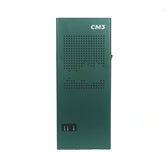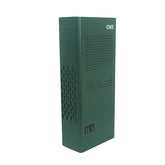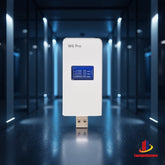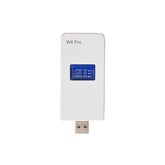Which Jammer to Choose?
Before buying a Jammer you need to keep in mind some factors:
Which frequencies the devices we want to inhibit use;
How much output power do the devices to be inhibited use;
How much output power does the Jammer need;
How much distance must the Jammer get to inhibit;
The power supply must be direct current, battery or both;
The time that the Jammer must remain in operation and the relative cooling system.
Let's analyze the importance of each point.
What frequencies do the devices we want to inhibit use?
In order to disturb a device, it is necessary to first know at what frequency it transmits. Only after understanding the transmission frequency can we orient ourselves on which jammer to buy.
How much output power do the devices to be inhibited use?
Depending on the output power of the device, we must focus on a jammer that obviously has a higher output power, precisely to dominate the radio transmission of the device itself.
How much power output does the Jammer need?
The need to know the output power of the jammer is fundamental, both because it must be necessary to cover the output power of the device, and to be able to cover the entire area of interest.
How far must the Jammer get to inhibit?
Knowing the area you want to cover is one of the main points, the more Watts the jammer has for each band, the more the radius that will be covered, compared to a jammer with fewer Watts, will be greater.
Does the power supply have to be direct current, battery or both?
Another important point is to understand if in the environment in which the jammer will be installed, it can be powered by direct current or requires a battery. It must be said that the more powerful the jammer, the more it requires a greater power supply.
How long does the Jammer have to run and its cooling system?
The cooling system is the most underestimated point in the purchase phase. A major mistake, a jammer with an inadequate cooling system will present three huge problems:
After a few minutes, the performance will begin to decline, not performing as it should from spec;
Its temperature will increase exponentially with the consequence that its internal components are subject to irreparable failures;
Its life will be much shorter than a jammer which will have an adequate cooling system.
Taking into consideration these points mentioned above, you will have the certainty of having purchased the ideal jammer for your needs.
Which jammers do we recommend?
We obviously start from the needs, then move on to the jammer that will give us the solution to the problem.
How can I protect my privacy from GPS trackers and cellular frequency bugs?
For a car, a jammer that inhibits cellular and GPS frequencies is essential, with a range ranging from 5-15 meters maximum. The recommended jammer is undoubtedly the B39EVO.
I've always heard of the LoJack localization system for cars, how can I defend myself?
Although the B39EVO jammer also incorporates the LoJack frequency, it cannot inhibit it, for the reason indicated in point 2. The output power of the LoJack transmitter is far superior to any portable pocket jammer. The only solution is to opt for a non-pocket jammer, but a fixed one, however adaptable to cars. Example of such a device is the B69 and B69L, specifically, ask us if you want to disturb the loJack frequency, we will replace a UHF radio band for a specific LoJack with 20W output! Whereas, the LoJack transmitter transmits at a maximum power of 3W, the coverage is over 50 meters.
How can I inhibit the bugs and micro cameras installed in my car?
Generally, the bugs installed in cars transmit in the frequencies of cell phones, therefore GSM and 3G for micro cameras. The reason is simple, while for homes it is plausible to install radio frequency bugs, which can easily transmit via repeaters or even using your ADSL WiFi connection, reaching considerable distances, in cars this would be more problematic and unrealistic.
We therefore opt for the installation of these devices, which connect to cell phone repeaters, present all over the world, allowing environmental listening to the vehicle without borders, in every part of the globe. The recommended wifi jammer is always the same B39EVO.

How can I make the bugs in my home / office unusable?
Here the discussion becomes more articulated. Given the wide range of bugs present, which transmit at various frequencies, it is necessary to buy devices that cover as many bands as possible.
Our advice is to opt for two jammers, the B53EVO jammer and the B68H jammer.
The B53EVO jammer inhibits all:
VHF and UHF low frequency radio bugs;
Cell frequency bugs;
2.4-2.5 GHz radio bugs, WiFi - Bluetooth;
GPS locators;
3G and 4G LTE micro cameras.
The B68H jammer, on the other hand, inhibits all:
Bugs that transmit in cellular frequencies (GSM, GPRS, 3G and 4G);
High frequency radio bugs (5100-5500-5900 MHz)
The installation of these devices in an environment guarantees high safety within a range of 20-50 meters.
I would like to test the dialer of my alarm, which Jammer should I buy?
To cancel the transmission between the dialer of your alarm and the control panel, it is first necessary to know at what frequency the dialer itself transmits. For insurance reasons, there is certainly the GSM dialer, which is generally supported by a low and / or high radio frequency transmitter. In this specific case, it is essential to opt for a jammer that has a high output power, possibly with directional antennas.
The recommended jammer to cancel the GSM dialer is the B42EVO jammer. This jammer, thanks to its output power and its directional antennas, is able to reach considerable distances, as well as being able to go beyond the walls (obviously the range of action decreases according to the opposing walls between the jammer and the combiner. ).
For low radio frequencies, VHF and UHF, we recommend the B69 jammer. Derived from the same family as the B42EVO jammer, the B69 jammer also has a considerable output power and directional antennas, features that allow you to reach a considerable distance.
Finally, for high radio frequency transmitters, generally 5100-5500-5900 MHz, we recommend the B68H jammer
Attention! The choice of antennas is essential. For uses where the disturbance must be concentrated in a specific point, it is advisable to choose a jammer with directional antennas. In this way, all the power of the jammer is concentrated on the point of interest, thus exploiting 100% of the power, unlike only 50% for a jammer with omni-directional antennas.













